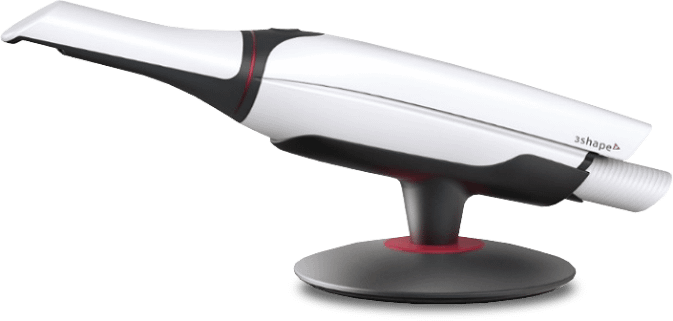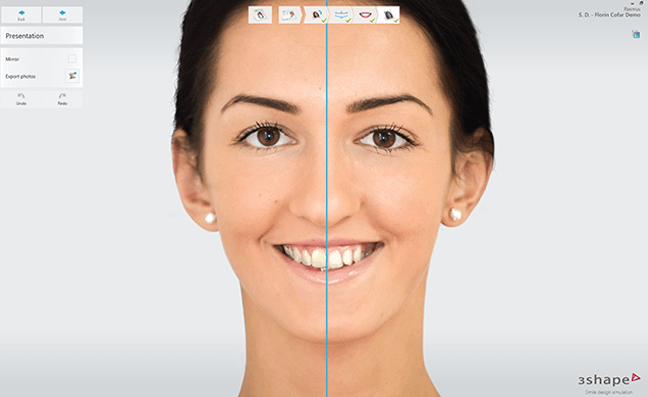Why 3Shape TRIOS 4 is so much more than an intraoral scanner
From GPs and orthodontists to surgeons and denturists, intraoral scanners have become an essential tool in the practice. Despite each specialism having its own needs, intraoral scanners have made workflows more efficient, and treatments more predictable and comfortable for patients.
3Shape had the opportunity to speak with a GP and a surgeon from France about their TRIOS 4 intraoral scanners. TRIOS 4 has become a routine part of their daily work.
General Practitioner, Dr. Edouard Lanoiselée previously owned a 3Shape TRIOS 3 MOVE intraoral scanner. He switched to the TRIOS 4 MOVE+ recently. He talks about the new scanner and the applications that come with it.
Dr. Edouard Lanoiselée: “The diagnostic and monitoring functions offered by TRIOS 4 and TRIOS Patient Monitoring caught my attention at IDS 2019. I find it essential to raise patient awareness not only about the actual treatment, but also about follow-up care. It is important for me to be able to lighten my busy schedule by seeing more patients for check-ups, rather than treatments.
 I find that the new scanner (TRIOS 4) is significantly faster. It makes it easier to scan all metal units. The tip heats up in just a few seconds – there is no waiting time, which is very helpful. I can also share the scanner with my colleague. She has her own TRIOS MOVE unit, I have mine, but we can quickly transfer the (wireless) scanner from one room to another after changing the tip.
I find that the new scanner (TRIOS 4) is significantly faster. It makes it easier to scan all metal units. The tip heats up in just a few seconds – there is no waiting time, which is very helpful. I can also share the scanner with my colleague. She has her own TRIOS MOVE unit, I have mine, but we can quickly transfer the (wireless) scanner from one room to another after changing the tip.
The long battery life is also highly convenient, as I see between 20 and 25 patients a day, I can sometimes last a whole day with a single battery.
Patients find scanning with the new TRIOS 4 tip more comfortable, too. I have patients who have been scanned with the very first TRIOS 2, then 3, then 4, and have told me that, for them, the experience and comfort of scanning improved with each scanner model.
I have a lot of tech-savvy patients who work in IT and fully understand the efforts we make in our practice to provide them care. They are always very curious: many ask me to take their printed dental model with them if there is one. One even asked me if I could export my impressions and give them to him, so I sent him the files in STL. It creates a different mode of communication. We spend our days treating our patients, but it's also nice to talk with them.
If I ever have difficulties with a case, I can directly contact my technician online and discuss the case with him, so patients really see how we work once they leave the chair. They realize that, in the end, it's not just the procedure in the office – it's everything that revolves around it, and that we really put ourselves at their service to treat them.”
With digital impressions you can add in-house clear aligners to your services
Clear aligners have become one of the fastest growing in-demand treatments in dentistry. Although doctors can easily send their digital scans to many different brand names, simpler cases may not need to be outsourced.
3Shape provides software for practices and private labs that enables them to design and produce their very own clear aligners based on TRIOS intraoral scans. These in-house workflows are much more cost effective, and the savings can be passed on to patients.
Dr. Edouard Lanoiselée: “We have more and more demand from adult patients who are looking for treatments that are as discreet as possible. Thus, invisible aligners fully meet their needs. I can treat simple cases directly at my office, and on more complex cases, I work together with the orthodontist.”
In a recent interview with USA orthodontist, Dr. Melissa Shotell, regarding in-house clear aligner production, she says “The very fact that you are making your own clear aligners creates a more competitive price in the market. A commercial lab costs between 1500-2000 USD for a case, by making the clear aligner yourself you can reduce that price to 500 USD or less at times. That cost savings is passed along to the patient. Which in turn means you end up with more cases and higher profitability. »
Engaging patients and diagnostics with 3Shape apps
3Shape TRIOS 4 is a unique intraoral scanner in that it comes with a set of apps included. Dubbed patient engagement apps, the four apps are: TRIOS Patient Monitoring, TRIOS Treatment Simulator, Smile Design and TRIOS Patient Specific Motion. Each app provides its own exclusive function that serves to not only engage patients but make it more transparent for the doctor to show a patient why they may need work or what a treatment result could end up looking like.
Dr. Lanoiselée talks about TRIOS Patient Monitoring and how he uses it with patients suffering from bruxism.
Dr. Edouard Lanoiselée: “With Patient Monitoring, I can identify elements that are invisible to the naked eye, because the software has a very fine scale of measurement allowing me to detect new signs of tooth substance loss. I can check whether the patient really wears his appliance, or whether there is a need to rebalance the occlusion or adjust some of the movements that the patient performs. Therefore, I ensure the long-term success of my treatment.
Performing a regular scan, which only takes 2 minutes, allows me to monitor these patients and raise their awareness. I can very quickly analyze the clinical situation and immediately correct a potential problem. It reassures the patient and increases the effectiveness of my treatments.
French surgeon, Dr. Thibaud Casas, talks about the insight TRIOS Patient Monitoring brings to his practice.
Dr. Thibaud Casas: “Dental migrations, erosions and abrasions are all pathologies that are difficult to quantify. Patient Monitoring allows you to easily select scans on a timeline and compare them with each other. It is a powerful indicator for the dentist who knows immediately if the treatment is effective (for example in orthodontics) or if the situation is deteriorating (tooth migration, erosion, etc.).
TRIOS Smile Design
Another patient engagement app included with TRIOS 4 is Smile Design. It has become extremely popular with both labs and practices. The two doctors continue.
Dr. Thibaud Casas: “I use Smile Design for communication, to illustrate my treatment proposals to patients before going further with the creation of mock-ups. This allows me to understand the patient's expectations and to prepare the temporization phase.”
 When talking about Smile Design, Dr. Lanoiselée compares the old days using conventional impressions to his present digital workflow with Smile Design.
When talking about Smile Design, Dr. Lanoiselée compares the old days using conventional impressions to his present digital workflow with Smile Design.
Dr. Edouard Lanoiselée: “Before, without a preliminary design, I could find myself on the day the restorations were placed with a patient who would say to me: "It doesn't suit me at all."
Recently, I had a patient who complained about the shape of his teeth but didn't know how to describe it to me. I took some photos, did a scan, and then worked a little with the patient in the chair, but he still found it difficult to explain what he would like to achieve on a smile design. So, I just said: "Bring me a picture of you when you were young, we'll try to use it as a basis." I asked my technician to make a removable mock-up, which I put in place at the patient's next visit.
Quite quickly, the patient noticed a positive change, but was still hesitant. So, I advised him to go home with the removable mock-up and ask his wife what she thought.
The next day, he replied: "Indeed, my wife told me that my teeth looked the same as when we got married." It's a beautiful image! The patient could not articulate the problem, but we managed to do it with him. He had an opportunity to take the treatment proposition home and validate it with his family in his usual environment.”
Should a dentist use an intraoral scanner?
Dr. Edouard Lanoiselée: “We try to convince the doctors that are digital skeptics every day. We tell them to do a test: keep a conventional impression and send the scans to a laboratory that will be able to process them properly. They will see that digitally the result is, in my opinion, more accurate and more efficient – where with conventional methods we will always need to go back and forth between the lab and the practice, which wastes a lot of time.
I think that professionals that are very cautious should try it, and then go step by step. Today, I take 95% of my impressions digitally, but I started at 1%. It's our patients who make us want to improve: patients who had come to us for a single-unit restoration (an inlay or a crown), will come back in a few years for a removable prosthesis, but will not want to have a putty impression, they will say: "I would like you to do it with the same protocol as before."
Dr. Thibaud Casas adds: “Yes, it's obvious. In the past, I've spent a lot of time mastering workflows, playing with files, picking tools without necessarily setting goals for myself. As the saying goes: "Experience is a lantern hanging on your back. It only sheds light on the path you already took." In the light of this lantern, I can only encourage my colleagues to set their objectives in the short, medium, and long term. Having done so, they will be able to choose their digital tools with complete peace of mind.
3Shape's software solutions are perfectly suited for this purpose, as they are scalable. The practitioner or the clinic can add modules as they grow in expertise.
As technology has advanced, it’s become easier and faster to work digitally. Today, passing from one 3Shape software to another within a workflow is very simple, because the interface and the tools are the same.”
Dr. Lanoiselée summed up the benefits of digital dentistry to his practice in this way, “A happy patient will talk to one patient, an unhappy patient will talk to ten.”